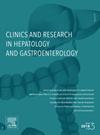内镜下愈合患者组织学愈合对溃疡性结肠炎病程的影响:一项前瞻性研究的结果
IF 2.4
4区 医学
Q2 GASTROENTEROLOGY & HEPATOLOGY
Clinics and research in hepatology and gastroenterology
Pub Date : 2025-09-28
DOI:10.1016/j.clinre.2025.102700
引用次数: 0
摘要
背景:STRIDE II指南承认内镜下愈合(EH)是溃疡性结肠炎(UC)的主要治疗目标之一。然而,组织学愈合(HH)可以降低UC长期并发症的风险。本研究的目的是评估UC复发的风险,这取决于缓解的程度。方法:我们进行了一项前瞻性研究,包括2021年1月至2024年1月期间所有临床缓解和EH (MES 0或1)的连续UC患者。主要终点是UC复发,定义为需要加强治疗和/或开始使用皮质类固醇和/或UC相关住院和/或结肠切除术。每6个月随访一次,随访2年。HH定义为Nancy指数≤1(盲法双读)。结果:共纳入75例患者。中位病程为12年(IQR[7.5-19.0]), 66例(82%)患者出现左侧结肠炎(E2)或全结肠炎(E3)。患者在结肠镜检查前平均治疗3年(IQR[1.2 - 6.9]), 49例(65%)患者MES为0。队列中59例(79%)患者患有HH。在中位随访21.0个月(IQR[12.0 - 26.5])后,13例患者(17%)在中位延迟11个月(IQR[6.0 - 18.0])后复发。MES 1和MES患者的复发风险无差异(分别为13.6% vs. 30.7% p = 0.275)。MES 1患者的复发风险明显高于无HH患者(分别为39.7%对20.1% p = 0.04)。同样,在MES 0患者中,无HH患者的复发风险明显更高(分别为70.0%和27.4%,p = 0.023)。随访期间无uc相关住院或结肠切除术报告。在多因素分析中,HH缺失是唯一与疾病复发相关的因素(HR 4.55 [1.69; 12.22], p = 0.0118)。结论:在这个前瞻性队列中,无论内镜下粘膜愈合程度如何,组织学愈合是唯一与UC患者长期预后改善相关的方法。本文章由计算机程序翻译,如有差异,请以英文原文为准。
Impact of histological healing on ulcerative colitis disease course among patients with endoscopic healing: results of a prospective study
Background
The STRIDE II guidelines recognize endoscopic healing (EH) as one of the main therapeutic goals in ulcerative colitis (UC). Nevertheless, histological healing (HH) could reduce the risk of long-term complications in UC. The aim of this study was to assess the risk of relapse in UC depending on the degree of remission achieved.
Methods
We conducted a prospective study including all consecutive UC patients in clinical remission and EH (MES 0 or 1) between January 2021 and January 2024. The primary endpoint was UC relapse, defined as the need for treatment intensification and/or corticosteroids initiation and/or UC-related hospitalization and/or colectomy. Patients were followed up every 6 months for two years. HH was defined as a Nancy index ≤ 1 (blinded double reading).
Results
A total of 75 patients were included. The median disease duration was 12 years (IQR [7.5–19.0]) and 66 (82 %) patients had a left side colitis (E2) or pancolitis (E3). Patients were treated for a median of 3 years (IQR [1.2 - 6.9]) prior to colonoscopy, 49 (65 %) patients had MES 0. Fifty-nine (79 %) patients of the cohort had HH. After a median follow-up of 21.0 months (IQR [12.0 - 26.5]), relapse was observed in 13 patients (17 %) after a median delay of 11 months (IQR [6.0 - 18.0]). There was no difference in the risk of relapse between patients with MES 1 and MES (13.6 % vs. 30.7 % respectively p = 0.275). The risk of relapse in patient with MES 1 was significantly higher among patient with absence of HH (39.7 % versus 20.1 % respectively p = 0.04). Similarly, in patients with MES 0, the risk of relapse was significantly higher among patients without HH (70.0 % versus 27.4 % respectively, p = 0.023). No UC-related hospitalizations or colectomy were reported during follow-up. In multivariate analysis, absence of HH was the only factor associated with disease relapse (HR 4.55 [1.69; 12.22], p = 0.0118).
Conclusion
In this prospective cohort, histological healing was the only associated with improved long-term outcome in UC patients whatever the degree of endoscopic mucosal healing.
求助全文
通过发布文献求助,成功后即可免费获取论文全文。
去求助
来源期刊

Clinics and research in hepatology and gastroenterology
GASTROENTEROLOGY & HEPATOLOGY-
CiteScore
4.30
自引率
3.70%
发文量
198
审稿时长
42 days
期刊介绍:
Clinics and Research in Hepatology and Gastroenterology publishes high-quality original research papers in the field of hepatology and gastroenterology. The editors put the accent on rapid communication of new research and clinical developments and so called "hot topic" issues. Following a clear Editorial line, besides original articles and case reports, each issue features editorials, commentaries and reviews. The journal encourages research and discussion between all those involved in the specialty on an international level. All articles are peer reviewed by international experts, the articles in press are online and indexed in the international databases (Current Contents, Pubmed, Scopus, Science Direct).
Clinics and Research in Hepatology and Gastroenterology is a subscription journal (with optional open access), which allows you to publish your research without any cost to you (unless you proactively chose the open access option). Your article will be available to all researchers around the globe whose institution has a subscription to the journal.
 求助内容:
求助内容: 应助结果提醒方式:
应助结果提醒方式:


